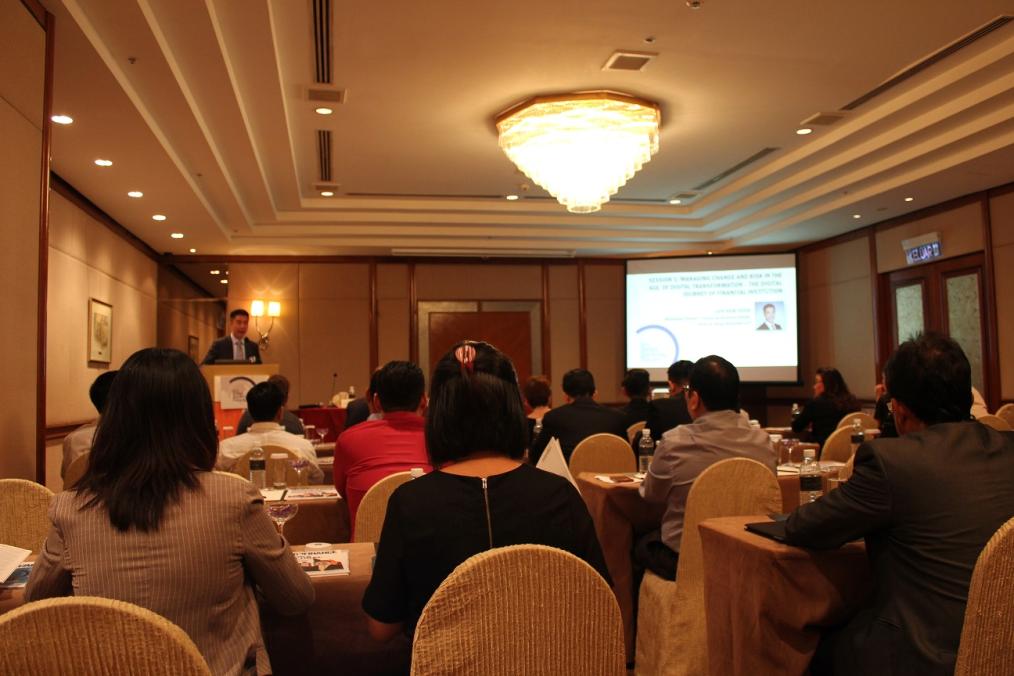
How are Malaysian banks dealing with the pressure of digitisation?
It's not just about the technology.
It's no surprise that financial institutions across the ASEAN are feeling the pressure of digitisation or risk being left behind. When Ernst and Young interviewed senior executives from banking, insurance, wealth and asset management institutions across the ASEAN region, the professional services giant found out the collective challenges in digitisations that are making financial institutions sweat.
This includes monetising the digital business, staying relevant to customers, creating a productive environment, managing compliance, and dealing with gripping digital risk. Digitisation, along with financial technology, were the buzz words among the topics discussed today at the Kuala Lumpur leg of Asian Banking and Finance’s Retail Banking Forum held at the Shangri-La Kuala Lumpur.
And it’s not like digitization is a walk in the park. “It’s not just about putting a technology in the front end,” said Liew Nam Soon, managing partner for financial services in ASEAN at Ernst and Young to open the forum. “At the end of the day, it’s about how your customers will be using the digital advancements, and whether or not they find it useful. Are [financial institutions] really deploying something that is relevant for the customer?”
Nam Soon stressed that too much emphasis is being placed by financial institution on the technology itself in terms of digital transformation, but are forgetting that the change permeates the entire institution. “Success of digital strategies depend on improvements to operational agility, flexibility, and relevance to customers,” he said. “This requires an organization-wide transformation.”
Additionally, Nam Soon said digital advancements are not just for the sake of innovating, but it also has to make money. He added that every single project for digital innovation must fulfill two objectives: Improving the customer experience and bringing in revenue stream.
Meanwhile, in order to stay relevant to customers, Nam Soon said financial institutions need to address customer needs and not demographics. In order to do this,
Nam Soon said FIs need to utilize data better and deliver a personalised experience. “Digital presents opportunities to reach into markets that are not accessible by traditional methods.” Nam Soon said. He also emphasised that nothing comes second to data when it comes to a financial institutions’ largest assets. “Transactional data is a treasure trove for FIs,” he said.
Despite this, Nam Soon says the branch is not going to go away soon. “People are always talking about the battle of the branch and digital innovations. A lot of financial institutions are developing the branch to cater to specific clients such as SMEs as branches provide human interaction.”
Following up the subject of branches, Dereck Daymond, vice president for software solutions, Asia Pacific of Phoenix, a Diebold company, said the role of the teller is going to undergo a rapid and radical change due to the increasing prevalence of self-service devices. “54% of the teller transactions can be completed by self-service,” Daymond said. “But that doesn’t mean that you should get rid of the teller. The teller could just be a lot more interactive so they can be more of a PR representative for the branch so they’ll be talking to [customers] and helping [them] instead of just dispensing cash or cashing cheques,” Daymond added.
While there’s no denying that self-service will become even more advanced and prevalent in the coming years, Daymond said the bar for user expectations is also being raised. “People are expecting more than just a boring screen. Users are becoming more fussy, and want more interactive experiences.” Daymond adds that mobile interaction is also a huge plus for these users, changing the way consumers interact with the self-service channel. “Mobile interactions include secure mobile-wallet download driven by near-field communication and mobile-first cash dispensers.”
While customers are increasing their interactions with ATMs, Daymond says this is also an opportunity for banks to know their customers via the ATM channel. “The ATM channel has become a strategic, vital touchpoint between your organization and your consumers,” Daymond added.
“Every time your customer uses your ATM, you know more about them. Use this opportunity to show them that there is an advanced relationship between the bank and the customer. You want to be able to have the kind of relationship that is more personalised,” Daymond said. ATM advancement is also exemplified as Diebold exhibited Irving, an eye-scanning, headless, pin-less, and cardless ATM, at the forum. The fast-cash dispenser also utilizes the consumer’s mobile device to complete a cash withdrawal in a little over 10 seconds.
Mobile devices are also as disruptive as they are ubiquitous. They are also the go-to device for millennials, which makes it a great deal for retail banks to harness the smartphone’s potential, according to Muzzaffar Othman, digital strategist at Maybank.
Speaking about the millennials, Othman said “Google is their friend, YouTube is their entertainment, social media is their change, and they are the future of financial institutions.” Othman said branch banking is not going to be popular among millennials. “[Millennials] would not do their transactions even once a month in bank branches,” Othman predicted. “There’s be less roles for the branch and more roles for digitalization and mobile.”
When talking about the strategies to cater to the declining interest for retail banks and challenges posed by FinTechs, Othman said banks have to collaborate and compete.
Meanwhile, the fourth session was a panel discussion with the topic ‘Assessing Malaysian Banks’ Profitability, Asset Quality and Funding Levels’. The panel was made up of Joel Kornreich, group chief executive officer of Alliance Bank Malaysia Berhad, and Vipin Agrawal, senior managing director and head of retail assets, cards, and deposits at CIMB. The panel was moderated by Asian Banking and Finance editor Tim Charlton.
According to Kornreich, a troubling issue for Malaysian banks is the structure of their balance sheets. “Big banks on the balance sheet on the asset side are either yielding very low yield or are essentially fixed even though they may be normally indexed.” Kornreich said. “You look at shophouse financing, which has very low yield, and you look at higher purchases which banks are not managing to make work from a returns perspective because they yields may be marginally higher but they just don’t remunerate the risk that you’re taking.”
Another issue for Malaysian banks, according to Kornreich, is their inefficient assets, putting discretion on the other side of the balance sheet, which is the funding side. “The funding is being constrained by the depreciation of local currency. As people try to move money out of the country or out of the currency, it means that you start to open up a gap between the evolution of the local funding versus the pool of assets.” Kornreich explained.
Kornreich said that the gap last year alone for the banking sector was a staggering MYR60-70b.
At the same time, Kornreich said, this environment has also fostered competition for funding, making banks more imaginative in ways for finding this funding.
Kornreich added that Malaysia’s banks are also dealing with increasing compliance costs. “Savings from consumers are valuable commodities [for banks] and the least valuable are very large corporate deposits. There’s more competition where the deposits are more desirable.”
This issue is also compounded by the fact that Malaysia is still lagging behind its peers in terms of analytics and risk management, Kornreich said. “How you price your assets is still rudimentary in a lot of places [in the country] as a result of inefficiencies in the system. However, Kornreich said that it is a golden opportunity for banks to invest in research and analytics. Predicting the future of Malaysian banks, Kornreich said “I think banks are going to diversify their source of the funding, they’re going to compete for the better source of the funding, it will get more sophisticated and interesting.”
On the other hand, CIMB’s Agrawal thinks the economic environment is a large factor which sways the tide either in favor of or against Malaysia’s financial institutions.
“The chain started on the US issues in 2008, and later European issues. Recently, the Ringgit depreciation and the China slowdown has also affected the banking environment in Malaysia,” he said. Regulatory pressure is also a concern for the country’s banks according to Agrawal, saying regulators are being active both inside and outside Malaysia, resulting in a rise in compliance costs.
FinTech is also a dividing issue among Malaysia’s banks according to Agrawal, and that he sees it as an opportunity to outsource the work to the consumers themselves. “In a cost reduction sense, 80-90% of all transactions are happening outside the branch. So it’s a fascinating decision of whether to collaborate or to compete.” Agrawal said.
Moreover, asset quality is also an international concern among banks, and Alliance Bank’s Kornreich believes asset quality in Malaysia is above par. The issue in the country, however, is that banks really don’t imply risk-based pricing in a disciplined way, according to Kornreich.
More than 40 bankers and industry players attended the Kuala Lumpur leg of the ABF Retail Banking Forum. The event will also be held in four more cities in the coming weeks Jakarta, Singapore, and Bangkok. To find out more about the event, click here.























 Advertise
Advertise







